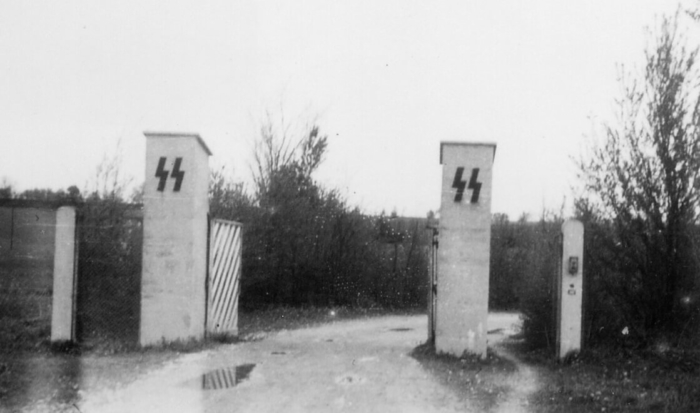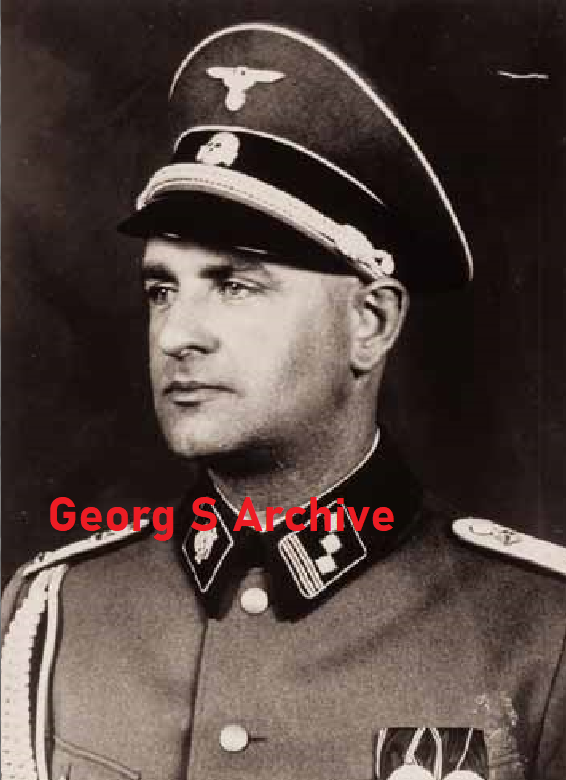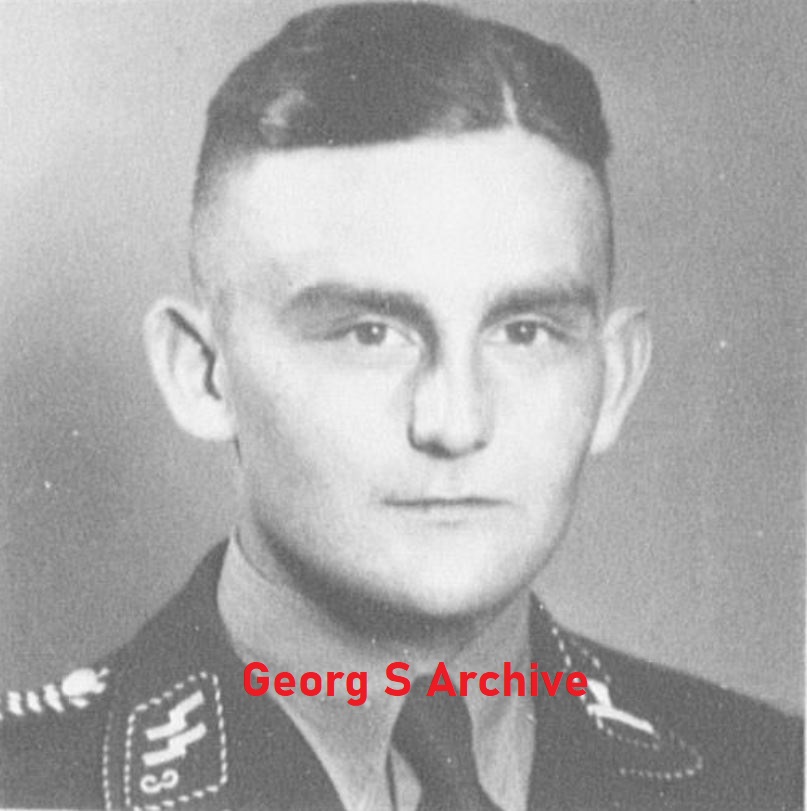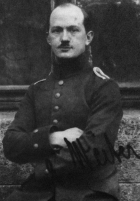1942
At the shooting range of SS-Standort Dachau you had the range at “Herbertshausen”, it´s 2 kilometers away north from the main camp. On this place the SS beside shooting practice conducted a war crime when they executed a lot of Russian POW´s there. the exact number is unknown. But we can count them in thousand. This kind of executions took place at several SS-Standorten such as Sachsenhausen, Buchenwald and other places. At Sachsenhausen they had a facility where the POW was supposed to get a medical check, and when they was telling him that they needed to measure his hight the POW took place by the wall, behind the wall an SS-Soldier stood ready with a gun. He opened a hatch a shot the POW in the back of the head. One of them was the so Called “pistolen schubert”.

The new Kommandant of the camp was in 1942 SS-Ostubaf Martin Weiss, who came from KL Neuengamme.

April 00, 1942
The Dachau SS Medical School, which was attached to the Dachau SS Hospital until 1942, was apparently closed in April 1942. Unfortunately, no further information is available on this, nor on the continued use of school staff.
(BA-MA N 756 Wolfgang Vopersal, SS Hospital Dachau, n.d., 2 pages, here p.1, see also BA-MA N 756 Wolfgang Vopersal, SS Medical School Dachau, n.d., 2 pages, here p.1)
However, the school reopened in December 1942 (field post receipt). Unfortunately (June 13, 2018), details are not known.

SS-Standortkommandant Dachau, 28.1.1943 SS-Oberführer Pfannenstiel
With effect from November 1, 1943, an SS regular company, e.g. V., was set up in Dachau. ordered.
- General:
a) The SS main company e.g.b.V. receives the designation
SS Stamm-Company e.g.V.
(SS Stammkp e.g. V.)
b) Leader of the SS Stamm-Kp. e.g.V.: SS-Hauptsturmführer Harms
He receives disciplinary powers according to DBO (mob) § 9.
c) The SS Stamm-Kp. e.g.V. reports directly to the SS Main Command Office. She works closely with Amt A II, Org.Abt. IE, instructed. Economically, the company is assigned to the SS location administration in Dachau.
d) Responsible for the formation of the SS Stamm-Kp. e.g.V. is SS-Hauptsturmführer Harms.
The completed list is sent to the SS-FHA, Org.Abt. Yes to report.
e) Postal address: SS-Stamm-Kp. e.g.V. Dachau 3/0 SS barracks.
2.) Structure:
A KStN does not apply to filling positions
3.) Personnel regulations:
Permanent staff are to be assigned by
SS-FHA Office V/IIa: 1 leader (seriously injured) as representative of the Kp. leader
1 guide for Abbot VI
SS-FHA Office II Org. Abt. IE: 1 staff sergeant
Additional permanent and training personnel will be formed into the SS-Stamm-Kp upon request by the SS-FHA, Org.Abt.IE. e.g.V. offset.
4.) Material provisions:
a) Weapons (for teaching purposes only) and training equipment will be provided upon request by SS-FHA, Org.Abt. Ib, assigned.
b) 2 le. Draft horses are to be assigned by SS-FHA, Office VI, the necessary harness equipment and 1 tow truck by SS-FHA, Office VII. takeover or The transfer must be made by mutual agreement.
c) Sports equipment, office supplies and equipment must be requested from SS-FHA.
d) Teaching materials are allocated upon request by SS-FHA, Regulations and Teaching Materials Department.
5.) Accommodation
First of all, accommodation with appropriate classrooms for 1,000 men must be provided by the SS Dachau location administration.
6.) Medical care is provided by the Dachau SS hospital.
7.) Tasks of the SS Stamm-Kp. e.g.V. are set out in a service instruction that is sent to the departments requiring cooperation. (not available, the author)
F.d.R. signed Hoffmann signed, Jü t t n e r
SS-Hauptsturmführer SS-Obergruppenführer and General of the Waffen-SS
(Copy from BA Berlin NS 19/ 1885 B.Arch.Kelling, provided to Uwe Kleinert 3.2008)
The formation of this company to record seriously injured members of the Waffen-SS was not only met with approval. Especially the head of the SS main office, the SS Obergruppenführer and general of the Waffen-SS Gottlob Berger, who only with effect from September 1, 1943, the SS convalescent battalion, the previous collection point for the troops’ war disabled people from the main welfare and supply office – SS had taken over the SS Main Office, saw this formation of the SS Main Office as a “competing company”.
Already in a letter dated October 29, 1943 to the Personal Staff of the Reichsführer-SS, SS-Obersturmbannführer Dr. Rudolf Brandt, CdSSHA/Be./We., VS-Tgb.No. 6768/43 case, Adjtr-Tgb.No. 3357/43, Berger explained: “Dear doctor!
It is unbearable for me to receive 1 or 2 things every day in which the orders or decisions given by the Reichsführer-SS are deliberately attacked. The matter is unbearable because I am certain that in the end I am the one who suffers, because a decision will either not be made or will be made in favor of the SS Headquarters. I’m tired of this now, and finally.
The Reichsführer-SS must intervene here and also point out to SS-Obergruppenführer Jüttner that he has to stick to the given orders and not constantly try – together with SS-Brigadeführer Dr. Haertel (the head of the main welfare and pension office SS, the author) – to sabotage the work. I am firmly convinced that the SS Stamm Company, for example, – which is what we are talking about here – is a competing company and so the uniformity is to be thwarted again.
It’s all pointless, and it would be best if my main office were to close down. What else should I do here? I have a big job to do at the front, but here at home I have to worry myself to death about things like this.
Letters arrive here every day. I submit today’s one to you. There are often up to 10 people who provide shocking evidence of how neither the main welfare and pension office nor the main management office did anything for the seriously injured. Now, after I took the matter into my own hands (taking over the SS-Gesenden-Btl., the author), you suddenly remember these things, and since you have all the technical and material possibilities, you can achieve this .
Dear doctor! You can say whatever you want this time. I’m too good to play the buffoon. Heil Hitler you…!”
(Copy from BA Berlin NS 19/ 1885 B.Arch.Kelling, provided to Uwe Kleinert 3.2008)
By March 1944 the SS Stamm-Kompanie z.b.V. For unknown reasons, probably due to lack of space, and at a previously unknown date, it had already been moved from Dachau to the SS “Germania” barracks in Hamburg-Langenhorn.
On March 23, 1944, the SS Obergruppenführer and General of the Waffen-SS Berger, CdSSHA/Be./We., wrote VS-Tgb.Nr. 211/44 g.Kdos, Adjtr.-Tgb.No. 193/44 g., again to the Personal Staff Reichsführer-SS, SS-Obersturmbannführer Dr. Rudolf Brandt, “Subject: SS Stamm-Kompanie z.b.V., Appendix: 1 process”: “Dear Doctor!
The Reichsführer-SS has ordered that I send you the report from my Office C III with all the appendices. In my opinion it is clear that this SS main company, for example, The SS Command Main Office has created a sieve through which only severely injured SS men who are no longer fit for action can get into the convalescent battalion.
“Hail Hitler, you…”
(Copy from BA Berlin NS 19/ 1885 B.Arch.Kelling, provided by Uwe Kleinert
1944
January 00, 1944
Relocation of the SS Leader School of the Administrative Service to Arolsen. (SS-Verwaltung Shule der SS)
In mid-November 1943, an SS advance commando from Dachau sounded out the SS barracks of the 2nd Battalion of the SS Regiment “Germania” on Große Allee in Arolsen, which had been empty after the SS Anti-Aircraft Training and Replacement Regiment had been relocated to Munich-Freimarn for accommodation options at an SS leadership school in the barracks. (Zimmer, Deckn.Arthur, p. 51)
On November 14, 1943, a transport list was compiled in the Buchenwald concentration camp, which included 11 German, 12 Polish, 7 Czech, 2 Luxembourgish prisoners as well as 1 Belgian and 1 Dutch prisoner, which was intended for the newly established external command at the SS leader school in Arolsen were. The prisoner Willy Apel was employed as a prisoner capo and reported after the war: “The SS leader school used to be in Dachau and was moved to Arolsen. Buchenwald then had to provide a work detail. … We were all loaded into a car, onto a truck with appropriate security, and drove off. … We had no idea where Arolsen was and what we would encounter. …” (Zimmer, Deckn.Arthur, p. 51, note 4 interview by B.Zimemr with W. Apel from October 23, 1987).
The Polish prisoner Ludwik Majka remembered the transport: “… In the afternoon our group – around 40 prisoners – was picked up by a truck type “Holzgas” with a tarpaulin. … The group of prisoners was guarded by six SS men – Croats in German uniform – who were sitting at the car door, the driver – a German – and the command leader sitting next to him. … We arrived in Arolsen on the same day between 9 and 10 p.m. The first few nights we slept on straw bags spread out between machines. …”
(Zimmer, Deckn.Arthur, p. 75, note 2, report from L. Majka to B. Zimmer)
For Arolsen… when putting together the transport of November 14, 1943, it had to be taken into account that it was an external commando within an SS barracks, so particular caution was required when selecting the prisoners. The profession was an important criterion.
According to the personnel file, ten of them were cooks, waiters or butchers, i.e. they practiced jobs that were urgently needed in the newly established SS leader school. The others had relative qualifications primarily for construction work, and only in three cases was no craft occupation listed: clerk, tax official, businessman. (Zimmer, Deckn.Arthur, p. 52)
The majority of staff and teachers at the SS Leader School of the Arolsen Economic and Administrative Service came from the SS barracks in Dachau, which was located directly next to the concentration camp, separated only by a narrow river.
Some prisoners were already assigned to work here, for example in the kitchen and in workshops. In the course of the relocation of the SS administration school or its expansion into the SS leader school of the economic administration service, in addition to the SS personnel, some prisoners from the concentration camp in Dachau also came to the SS barracks in Arolsen.
Former Dachau prisoner Bodgan Wozniak, who worked in the kitchen of the school in Dachau, recalled: “… Only a few people worked in the kitchen – about 14 in total. My boss’s name is K., an ethnic German from Tomaszow-Mazowiecki. … The boss among the waiters was called W., the head of administration was Wr. I also remember the accountant’s appearance. He was slim and had straight hair. … Our departure took place on December 23, 1943. … We took the train to Arolsen under the supervision of two older security guards. …” 9 men on the transport were German, 11 were Poles, 3 were Yugoslavs, 2 were French and 1 was Belgian. A total of 26 prisoners from KL Dachau were transferred to the Arolsen external command and, for administrative reasons, were formally transferred to KL Buchenwald on December 27, 1943.
Here, too, these were mainly craftsmen who were needed in Arolsen for work in the kitchen and workshops. In the monthly calculation for January 1944 for the Arolsen external command, the arrival of the Dachau transport was noted for January 7, 1944; the number of prisoners increased from 34 to 60. With a transport of a further 12 Poles and 6 Russians, the strength of the prisoner command in the SS barracks, together with the 20 prisoners from the Arolsen SS clothing camp, reached 98 male prisoners.
(Zimmer, Deckn.Arthur, pp. 101 – 103, Fig. 3.22, 142, for further development see also pp. 142-156)

In January 1944 the school moved to Arolsen. Almost at the same time, in February 1944, it also received a new commander, SS-Oberführer Georg Bochmann, who was supposed to take over the school with effect from November 1, 1943, but whose transfer had been canceled at the time.
(Jan Erik Schulte, Forced Labor and Extermination, The Economic Empire of the SS – Oswald Pohl and the SS Economic Administrative Main Office 1933 – 1945, Schöningh-Verlag, Paderborn, 2001, 68)
In 1943 Eduard Weiter took over the Co´ of the KL Dachau. He would held this command until almost the end of the camp, april 1945.

April 20, 1944
47.Cooking course v. April 20, 1944 – May 17, 1944 SS training kitchen Dachau
(Photo SS training kitchen Dachau in DF 4/74 inside back cover, the 48th course ran in Oranienburg from May 20th to June 17th, 1944, up to then around 1,750 troop cooks, kitchen bookkeepers and master chefs had been trained in Oranienburg, see also Kaienburg, Sachsenhausen , p. 344))
September 14, 1944
At the same time as other commanders, the commander in WW VII decided to fundamentally change the command structure in his military district. With the command deputy. Gen.Kdo VII.AK (Wehrkreiskommando VII), Az 35, No. 3010/44 g.Kdos, Ia, v. On September 14, 1944, this was now divided into “protected areas” and subordinate “protected areas” instead of the previous location areas. The accommodation areas of the two replacement divisions located in the WWF became protected areas:
Protected area “West” Div.No. 407 Augsburg
Protected area “East” Div.No. 467 Garmisch
Protected area “Mitte” location areas Munich, Fürstenfeldbruck
By order of March 16, 1945, Ref. A1, No. 1400/45, the Dachau district, previously the East Protected Area, was assigned to the Central Protected Area.
This reorganization of the military district served to increase the performance and training of troop leadership. The protected areas were divided into a total of 14 protected areas. The provisions on the subordination relationships stated: “.. All army troops located in their area and the alarm units of the Luftwaffe, the Waffen SS and the labor service are subordinate to the commanders of the protected areas….” A special feature should be mentioned that the Gauleiters also signed this order.
From then on, the respective troop commanders replaced the site elders in the protected areas and areas. The Central Protected Area, whose commander was the Wehrmacht commander from Munich, received its own general staff officer to align it with the two division staffs 407 and 467.
With the new protected area regulations, well-rehearsed staff members were now available for the ever-increasing territorial tasks. Simulation games for use against airborne landings and insurgent foreign workers were carried out everywhere in the following period.
(Joachim Brückner, End of the War in Bavaria, individual writings on the military history of the Second World War 30 MGFA, pp. 14 – 15, here BA-RH 53-7/1212)
November 00, 1944
- Cooking course at the “Waffen SS training kitchen” in November 1944 (found on eBay)
https://www.forum-der-wehrmacht.de/index.php?thread/23660-ss-lehrk%C3%BCchen/
November 00, 1944
At the end of October or beginning of November 1944, the SS main company z.b.V., which was originally set up in Dachau, returned to Dachau from Hamburg.
On November 15, 1944, the SS Main Office announced in the VOBl d. W SS, 5th year, 1944, v. 11/15/44, point 96 transfers, the transfer of the SS-Stammkp.z.b.V. from Hamburg-Langenhorn to Dachau. (N. Heitman dated March 7, 2000)
Apparently Dachau wasn’t supposed to be the “last solution”, but actually Graz-Tobelbad.
In the Ordinance Gazette of the Waffen-SS, 6th year, 1945, No. 3 from February 1st, 1945 it is stated under
Number 99 Deployment to the SS Stamm-Kp. e.g.V., arranged:
From the SS Stamm-Kp. e.g.V. So far only parts have been relocated to Graz – Tobelbad. The reception center is still in Dachau. March marches and all correspondence must therefore still be routed via Dachau.
(Telephone message from Uwe Kleinert dated May 11, 2008)
“…Harms once gave the reason for the change of quarters to M.-B. told. … Harms refused to use his disabled soldiers to guard the Neuengamme concentration camp in case an Allied landing took place on the North Sea coast. The concentration camp guards were then supposed to go into combat and Harm’s unit was supposed to take over the guard. This is how it turned out. Bassewitz-Behr and was then very angry. Harms also received a promotion ban, which would explain his rank of Hauptsturmführer in this large unit. Said to have been sometime in October/November 1944. Christmas was already celebrated in Graz. …
Harm’s wife, who is a few years older than him, comes from the Graz corner. ….” (Andre Freit from May 12, 2008)
The exact time of the company’s transfer to Graz is not known, but it was probably no longer in Dachau in April 1945!
Author Roland Pfeiffer (small part Georg Schwab) Images Georg Schwab
Final part will be published tomorrow.


